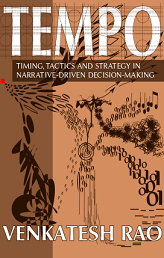A counter-intuitive feature of wind power is that it is usable regardless of the direction the wind is blowing, so long as it is sufficiently steady and you have the right technology. A windmill that can pivot, or a sailboat, can make use of any kind of steady wind. A sailboat can sail in any direction relative to the wind, though it may have to to tack or jibe to do so. But if there’s no wind, the sails are useless. You have to row or burn fuel.
The metaphor of a steady wind is more expressive than that of a rising tide. A rising tide floats all boats, but all go in only one direction: up. By contrast, a steady wind eases all journeys, regardless of direction. Imagine a cluster of sailboats huddled together in a windless doldrums. Once a wind starts blowing, all can start moving. And if they’re all headed to different places, they will start moving apart. The little boat cluster will experience expansion.
Imagine a steady wind blowing across an infinite two-dimensional ocean, a worldwind. The little boat universe on it will experience expansion.
[Read more…]








